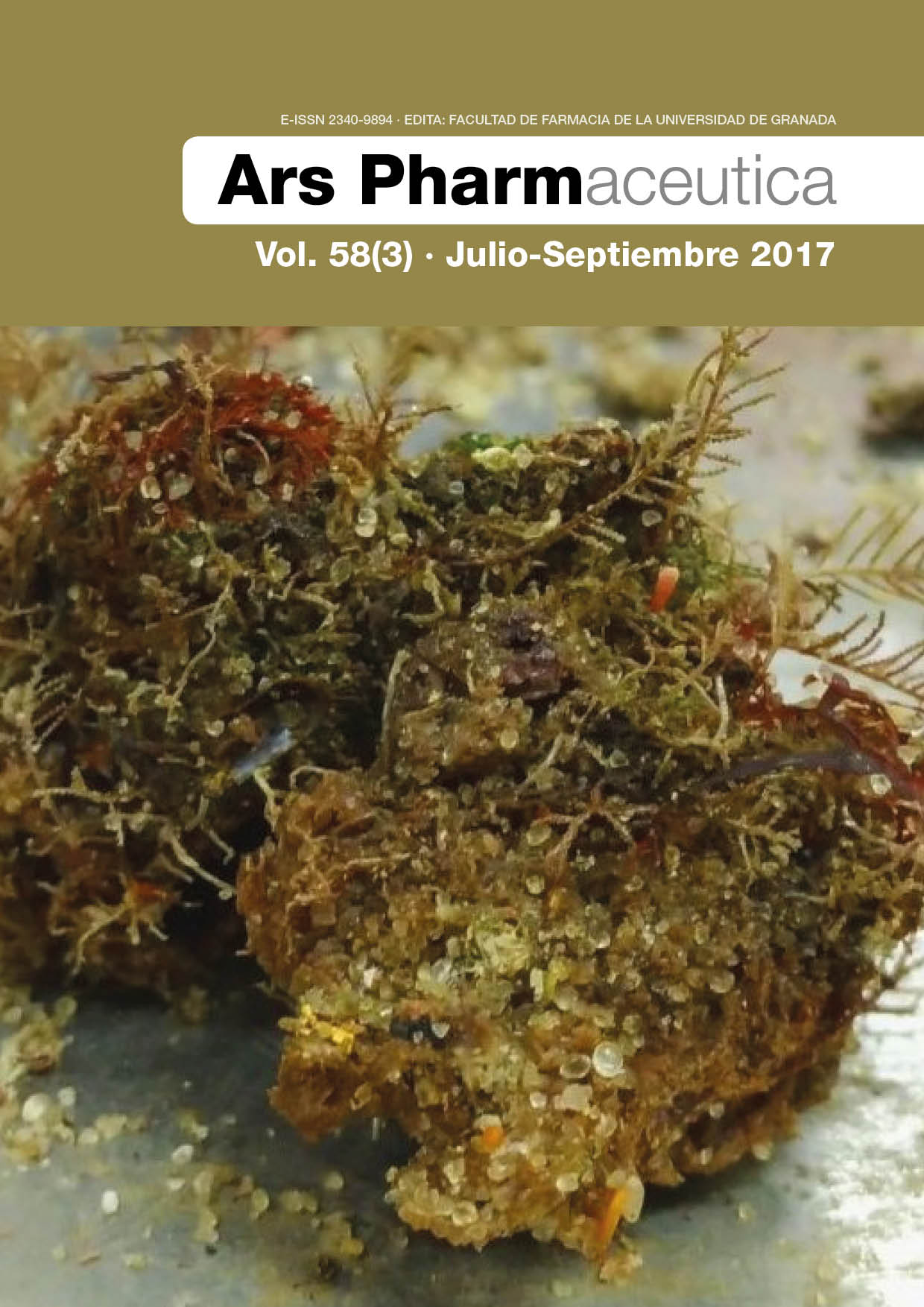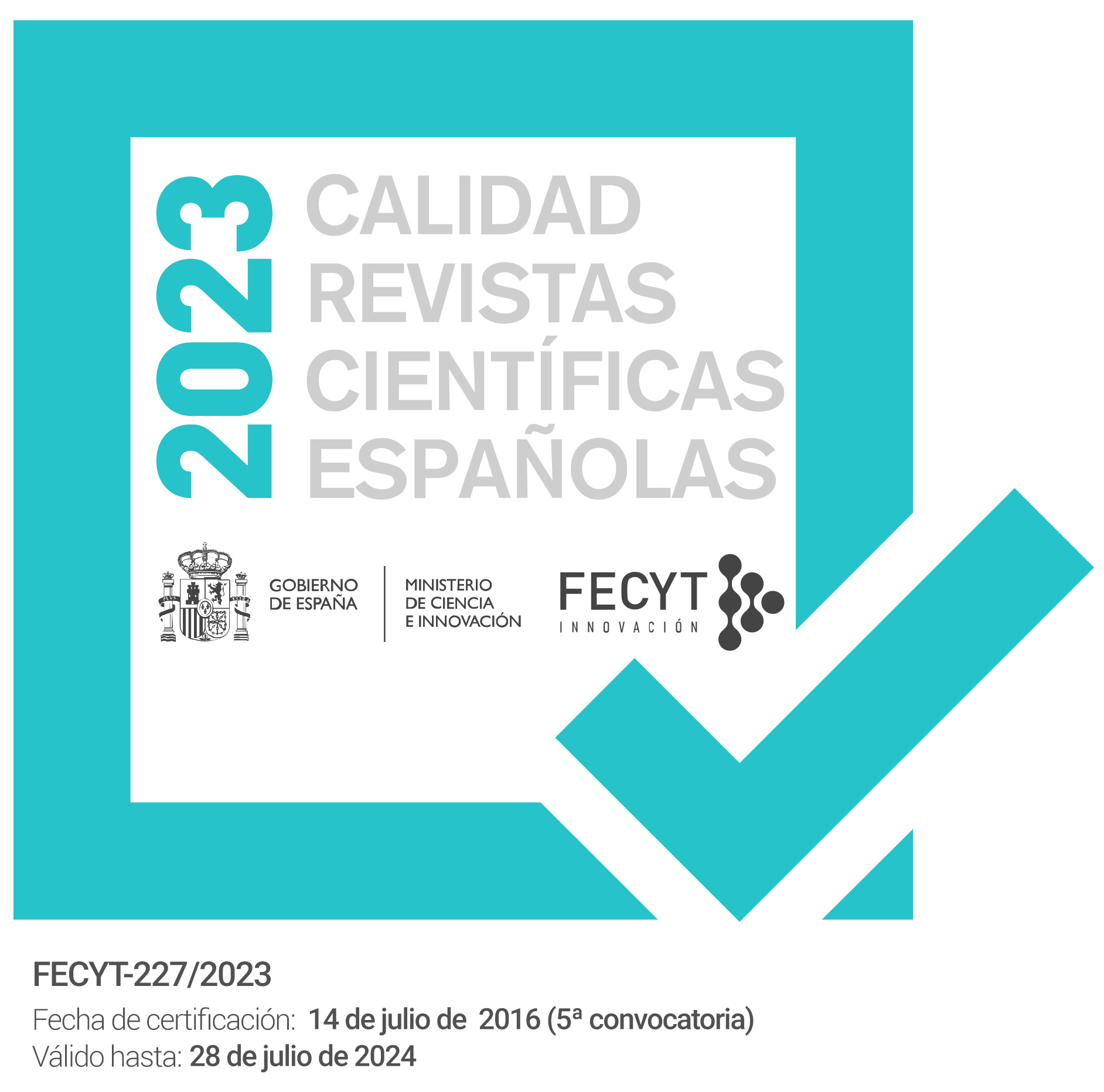A simple route for preparation of pH-sensitive hydrogels by using egg white proteins in alginate scaffold for the encapsulation of probiotics
DOI:
https://doi.org/10.30827/ars.v58i3.6530Keywords:
Encapsulation, probiotic, smart hydrogels, Alginate and egg white proteinsAbstract
Aims: In the present study, we evaluated the use of egg white proteins in alginate scaffolds and calcium alginate for the formulation of Lactobacillus casei and Lactobacillus acidophilus in the stomach acidic conditions.
Material and Methods: after microorganism’s encapsulation in egg white proteins in alginate, survival assays and release in different conditions were evaluated. Scanning electron microscope and Fourier-transform infrared spectroscopy were used for analysis.
Results: The results showed the high potential of this type of formulation in protecting the probiotics from stomach acidic conditions that is due to the significant increase in survival of the bacteria. Our study showed that the viability of the L. casei to free L. acidophilus had much less, however, with the encapsulation of the bacteria Egg white proteins in Alginate increased their survival significantly. Specially for the L. casei. Swelling and shrinkage behavior of egg white proteins in alginate capsules in different pH showed that the swelling of the capsule in the distilled water in the neutral terms had more inflation- capacity than similar position in terms of gastric acidity.
Conclusions: the use of egg white proteins-Alginate for encapsulation of probiotics enhanced the stability of these microorganisms in simulated gastric environments adverse conditions.
Downloads
References
Fioramonti J, Theodorou V, Bueno L. Probiotics: what are they? What are their effects on gut physiology? Best Pract Res Clin Gastroenterol. 2003;17(5):711-724.
Jabbari V, Khiabani MS, Mokarram RR, et al. Lactobacillus plantarum as a Probiotic potential from Kouzeh Cheese (Traditional Iranian Cheese) and Its Antimicrobial Activity. Probiotics Antimicrob Proteins. 2017;9(2):189-193.
Jabbari V, Mokarram RR, Khiabani MS, et al. Molecular Identification of Lactobacillus acidophilus as a probiotic potential from traditional doogh samples and evaluation of their antimicrobial activity against some pathogenic bacteria. Biomed Res -india 2017;28(4):1458-1463.
Moghaddam MZ, Nahaei MR, Kafil HS, Safaeyan F. Bacteriocins of Four Lactobacilli Species Isolated from Yogurt can Inhibit Growth and Verotoxins Production in E. coli O157: H7. J Pure Appl Microbiol. 2014;8(6):4517-4524.
Henriksson A, Khaled AKD, Conway PL. Lactobacillus Colonization of the Gastrointestinal Tract of Mice After Removal of the Non-Secreting Stomach Region. Microb Ecol Health Dis. 1999;11(2): 96-99.
Dahroud BD, Mokarram RR, Khiabani MS, et al. Low intensity ultrasound increases the fermentation efficiency of Lactobacillus casei subsp.casei ATTC 39392. Int J Biol Macromo. 2016;86:462-467.
McFarland LV. Meta-analysis of probiotics for the prevention of antibiotic associated diarrhea and the treatment of Clostridium difficile disease. American J Gastroenterol. 2006;101(4):812-822.
Shah NP. Functional cultures and health benefits. Int Dairy J. 2007;17(11):1262-1277.
Schoebitz M, Ceballos C, Ciamp L. Effect of immobilized phosphate solubilizing bacteria on wheat growth and phosphate uptake. J Soil Sci Plant Nutr. 2013;13(1)1-10.
Lee KY, Mooney DJ. Alginate: Properties and biomedical applications. Prog Polym Sci. 2012;37(1):106-126.
Goh CH, Heng PWS, Chan LW. Alginates as a useful natural polymer for microencapsulation and therapeutic applications. Carbohydr Polym. 2012;88(1):1-12.
Sun J, Tan H. Alginate-Based Biomaterials for Regenerative Medicine Applications. Mater. 2013;6(4):1285-1309.
Alleoni ACC. Albumen protein and functional properties of gelation and foamin. Scientia Agricola. 2006;63:291-298.
Livney YD. Milk proteins as vehicles for bioactives. Cur Opin Colloid Interf Sci. 2010;15(1–2):73-83.
Doherty SB, Auty MA, Stanton C, Ross RP, Fitzgerald GF, Brodkorb A. Survival of entrapped Lactobacillus rhamnosus GG in whey protein micro-beads during simulated ex vivo gastro-intestinal transit. Int Dairy J. 2012;22(1):31-43.
Gunasekaran S, Ko S, Xiao L. Use of whey proteins for encapsulation and controlled delivery applications. J Food Engin. 2007;83(1):31-40.
Lohcharoenkal W, Wang L, Chen YC, Rojanasakul Y. Protein Nanoparticles as Drug Delivery Carriers for Cancer Therapy. Biomed Res Int. 2014;2014:12.
Yamamoto T, Juneja LR, Hatta H, Kim M. Hen Eggs: Basic and Applied Science. Taylor & Francis; 1996.
Alderton G, Fevold HL. Direct crystallization of lysozyme from egg white and some crystalline salts of lysozyme. J Biol Chem. 1946;164:1-5.
Mukhopadhyay S. Removal of Salmonella Enteritidis from commercial unpasteurized liquid egg white using pilot scale cross flow tangential microfiltration. Int J Food Microbiol. 2010;142(3):309-17.
Rao AV, Shiwnarain N, Maharaj I. Survival of Microencapsulated Bifidobacterium pseudolongum in Simulated Gastric and Intestinal Juices. Can Instit Food Sci Technol J. 1989;22(4):345-349.
Callow JA, Osborne MP, Callow ME, Baker F, Donald AM. Use of environmental scanning electron microscopy to image the spore adhesive of the marine alga Enteromorpha in its natural hydrated state. Colloids Surf B: Biointerfaces. 2003;27(4):315-321.
Narra K, Dhanalekshmi U, Rangaraj G, et al. Effect of Formulation Variables on Rifampicin Loaded Alginate Beads. Iran J Pharma Res. 2012;11(3):715-721.
Mitropoulou G, Nedovic V, Goyal A, Kourkoutas Y. Immobilization Technologies in Probiotic Food Production. J Nutr Metabol. 2013;2013:716861.
Mokarram RR, Mortazavi SA, Najafi MBH, Shahidi F. The influence of multi stage alginate coating on survivability of potential probiotic bacteria in simulated gastric and intestinal juice. Food Res Int. 2009;42(8):1040-1045.
Mohan A, Rajendran SRCK, He QS, Bazinet L, Udenigwe CC. Encapsulation of food protein hydrolysates and peptides: a review. RSC Adv. 2015;5(97):79270-79278.
Chen CC, Chen ST, Hsieh JF. Proteomic analysis of polysaccharide-milk protein interactions induced by chitosan. Molecules. 2015;20(5): 7737-7749.
Heidebach T, Först P, Kulozik U. Microencapsulation of probiotic cells by means of rennet-gelation of milk proteins. Food Hydrocoll. 2009;23(7):1670-1677.
Chen M-Y, Zheng W, Dong Q-Y, Li Z-H, Shi L-E, Tang Z-X. Activity of encapsulated Lactobacillus bulgaricus in alginate-whey protein microspheres. Brazilian Arch Biol Technol. 2014;57:736-741.
Doleyres Y, Fliss I, Lacroix C. Quantitative determination of the spatial distribution of pure- and mixed-strain immobilized cells in gel beads by immunofluorescence. Appl Microbiol Biotechnol. 2002;59(2-3):297-302.
Doleyres Y, Fliss I, Lacroix C. Continuous production of mixed lactic starters containing probiotics using immobilized cell technology. Biotechnol prog. 2004;20(1):145-150.
Harnsilawat T, Pongsawatmanit R, McClements DJ. Characterization of β-lactoglobulin-sodium alginate interactions in aqueous solutions: A calorimetry, light scattering, electrophoretic mobility and solubility study. Food hydrocoll. 2006;20(5):577-585.
Tadera K, Minami Y, Chohchi M. Interaction between Acidic Polysaccharides and Proteins. Biosci Biotechnol Biochem. 2003;67(8):1840-1843.
Downloads
Published
How to Cite
Issue
Section
License
The articles, which are published in this journal, are subject to the following terms in relation to the rights of patrimonial or exploitation:
- The authors will keep their copyright and guarantee to the journal the right of first publication of their work, which will be distributed with a Creative Commons BY-NC-SA 4.0 license that allows third parties to reuse the work whenever its author, quote the original source and do not make commercial use of it.
b. The authors may adopt other non-exclusive licensing agreements for the distribution of the published version of the work (e.g., deposit it in an institutional telematic file or publish it in a monographic volume) provided that the original source of its publication is indicated.
c. Authors are allowed and advised to disseminate their work through the Internet (e.g. in institutional repositories or on their website) before and during the submission process, which can produce interesting exchanges and increase citations of the published work. (See The effect of open access).























